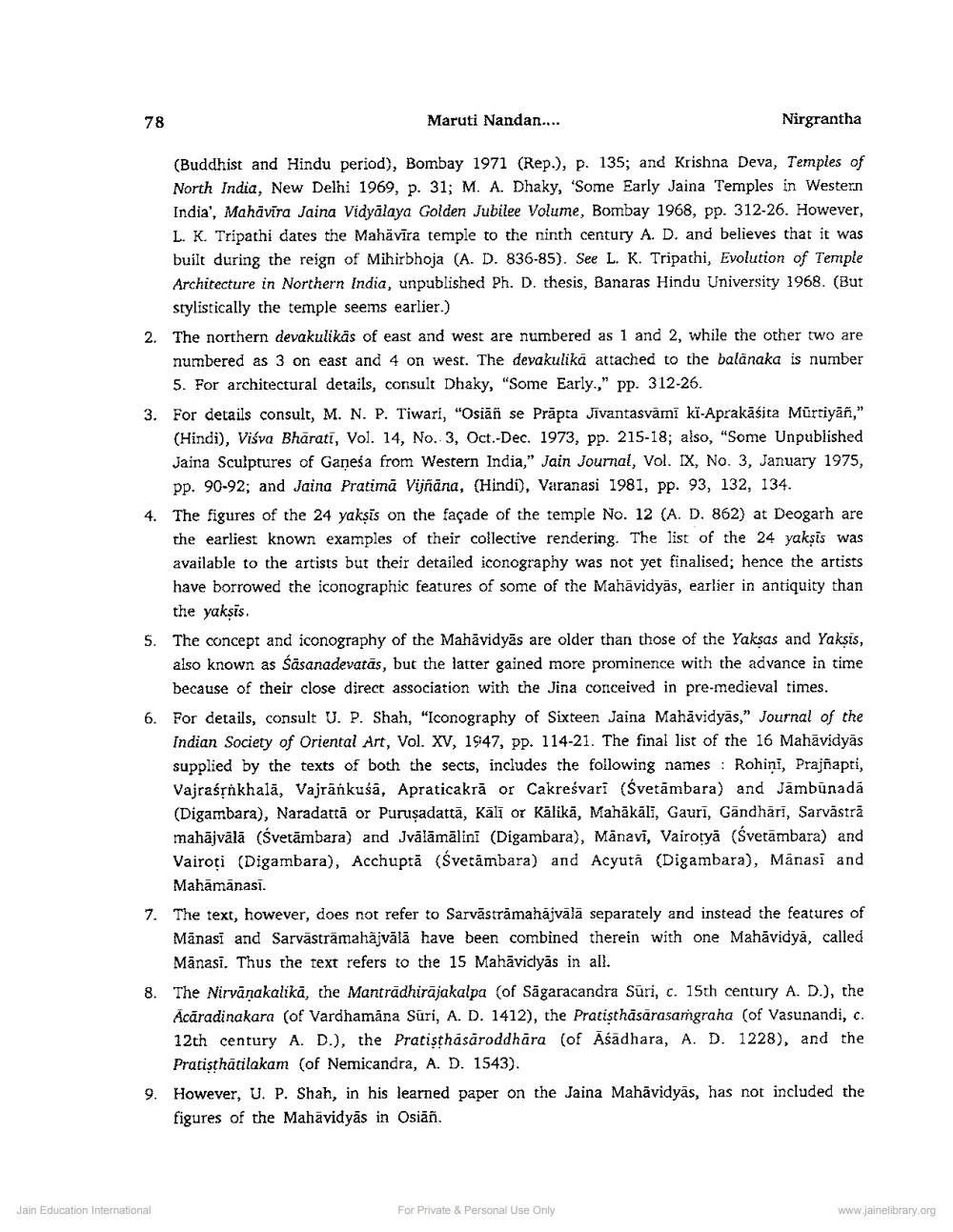Book Title: Jaina Mahavidyas in Osian Author(s): Maruti Nandan Prasad Tiwari, Kamalgiri Publisher: Z_Nirgrantha_1_022701.pdf and Nirgrantha_2_022702.pdf and Nirgrantha_3_022703.pdf View full book textPage 9
________________ 78 Maruti Nandan.... Nirgrantha (Buddhist and Hindu period), Bombay 1971 (Rep.), p. 135; and Krishna Deva, Temples of North India, New Delhi 1969, p. 31; M. A. Dhaky, 'Some Early Jaina Temples in Western India', Mahāvīra Jaina Vidyalaya Golden Jubilee Volume, Bombay 1968, pp. 312-26. However, L. K. Tripathi dates the Mahāvīra temple to the ninth century A. D. and believes that it was built during the reign of Mihirbhoja (A. D. 836-85). See L. K. Tripathi, Evolution of Temple Architecture in Northern India, unpublished Ph. D. thesis, Banaras Hindu University 1968. (But stylistically the temple seems earlier.) 2. The northern devakulikās of east and west are numbered as 1 and 2, while the other two are numbered as 3 on east and 4 on west. The devakulikā attached to the balanaka is number 5. For architectural details, consult Dhaky, "Some Early.," pp. 312-26. 3. For details consult, M. N. P. Tiwari, "Osiäñ se Prapta Jivantasvāmi ki-Aprakāśita Mürtiyan," (Hindi), Viśva Bharati, Vol. 14, No. 3, Oct.-Dec. 1973, pp. 215-18; also, "Some Unpublished Jaina Sculptures of Ganesa from Western India," Jain Journal, Vol. IX, No. 3, January 1975, pp. 90-92; and Jaina Pratimă Vijñāna, (Hindi), Varanasi 1981, pp. 93, 132, 134. The figures of the 24 yaksis on the facade of the temple No. 12 (A. D. 862) at Deogarh are the earliest known examples of their collective rendering. The list of the 24 yaksis was available to the artists but their detailed iconography was not yet finalised; hence the artists have borrowed the iconographic features of some of the Mahavidyās, earlier in antiquity than the yaksis 5. The concept and iconography of the Mahavidyās are older than those of the Yaksas and Yaksis, also known as Śäsanadevatās, but the latter gained more prominence with the advance in time because of their close direct association with the Jina conceived in pre-medieval times. 6. For details, consult U. P. Shah, "Iconography of Sixteen Jaina Mahavidyās," Journal of the Indian Society of Oriental Art, Vol. XV, 1947, pp. 114-21. The final list of the 16 Mahāvidyās supplied by the texts of both the sects, includes the following names : Rohini, Prajñapti, Vajraśộnkhalā, Vajränkuśā, Apraticakrā or Cakreśvari (Svetāmbara) and Jāmbūnada (Digambara), Naradattā or Puruşadattā, kāli or Kālikā, Mahākāli, Gaurī, Gandhari, Sarvāstrā mahājvālā (svetāmbara) and Jvālāmālini (Digambara), Mānavi, Vairotyä (svetāmbara) and Vairoţi (Digambara), Acchuptā (svetāmbara) and Acyută (Digambara), Mānasi and Mahāmānasi. 7. The text, however, does not refer to Sarvāstrāmahajvala separately and instead the features of Mānasi and Sarvāstrāmahājvālā have been combined therein with one Mahavidya, called Mānasi. Thus the text refers to the 15 Mahāviclyas in all. 8. The Nirvanakalikā, the Mantrādhirajakalpa (of Sagaracandra Sūri, c. 15th century A. D.), the Acāradinakara (of Vardhamana Sūri, A. D. 1412), the Pratisthāsārasamgraha (of Vasunandi, c. 12th century A. D.), the Pratisthasaroddhāra (of Āsādhara, A. D. 1228), and the Pratisthätilakam (of Nemicandra, A. D. 1543). 9. However, U. P. Shah, in his learned paper on the Jaina Mahāvidyās, has not included the figures of the Mahavidyās in Osiān. Jain Education International For Private & Personal Use Only www.jainelibrary.orgPage Navigation
1 ... 7 8 9 10 11 12 13 14 15 16 17 18 19 20
